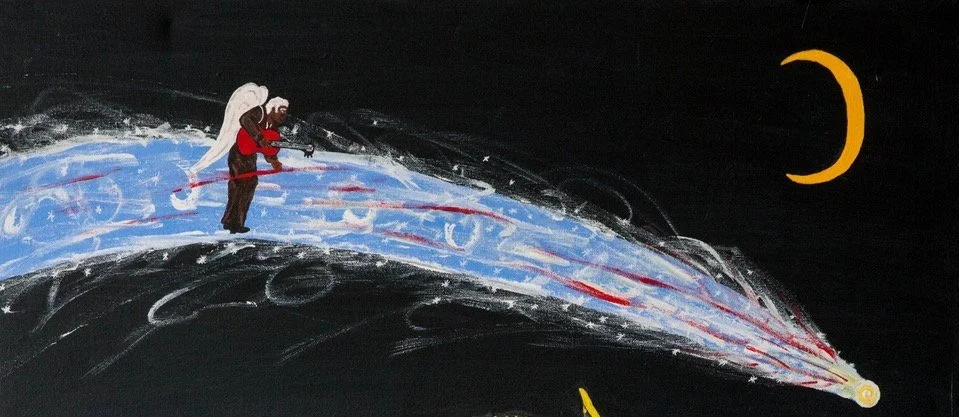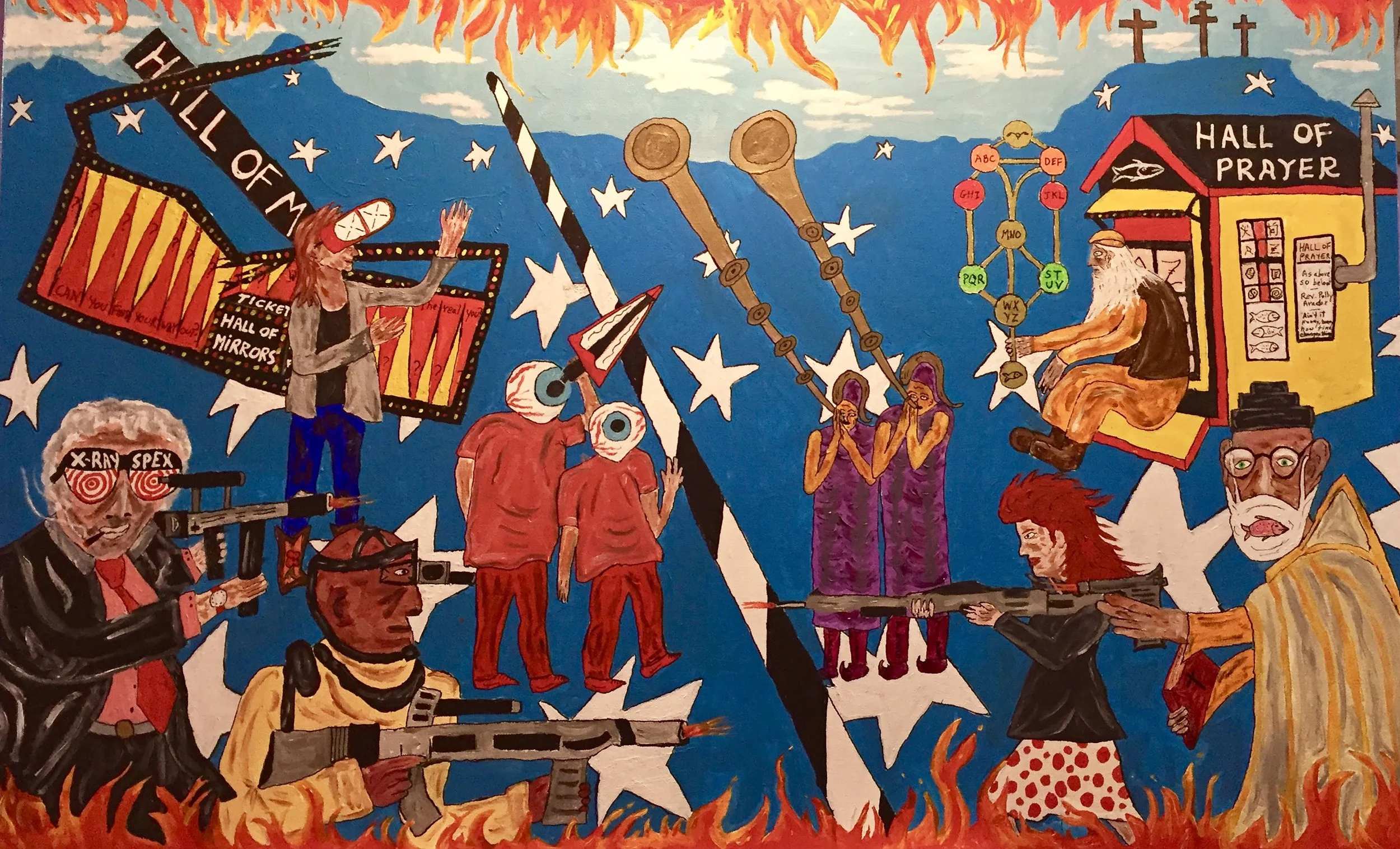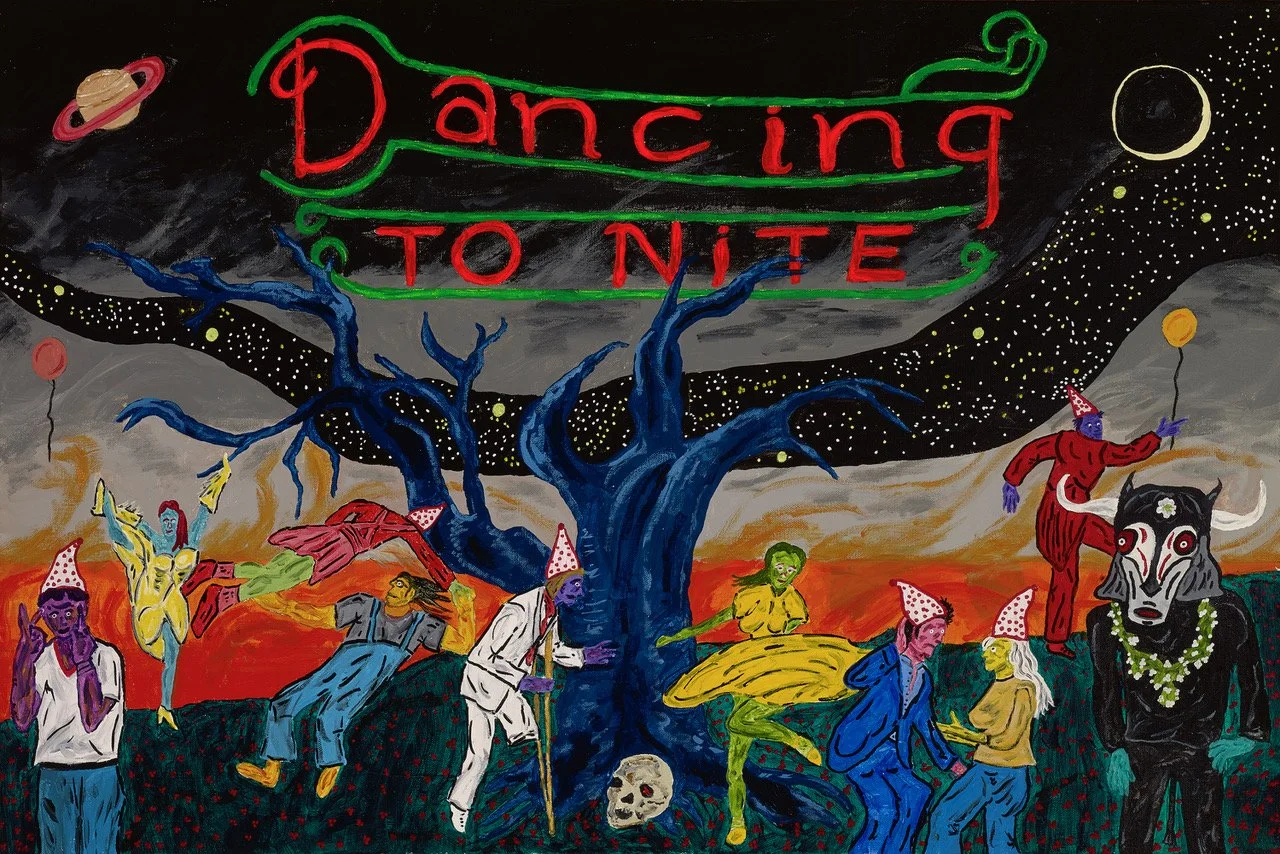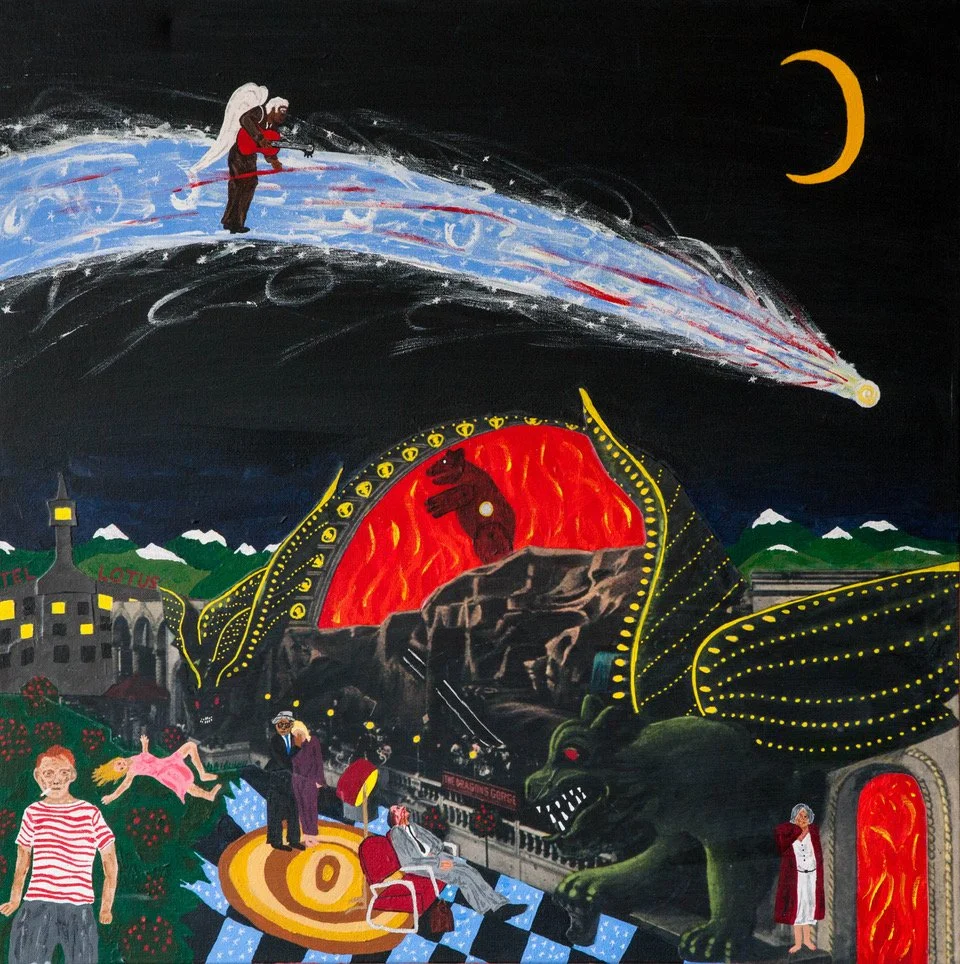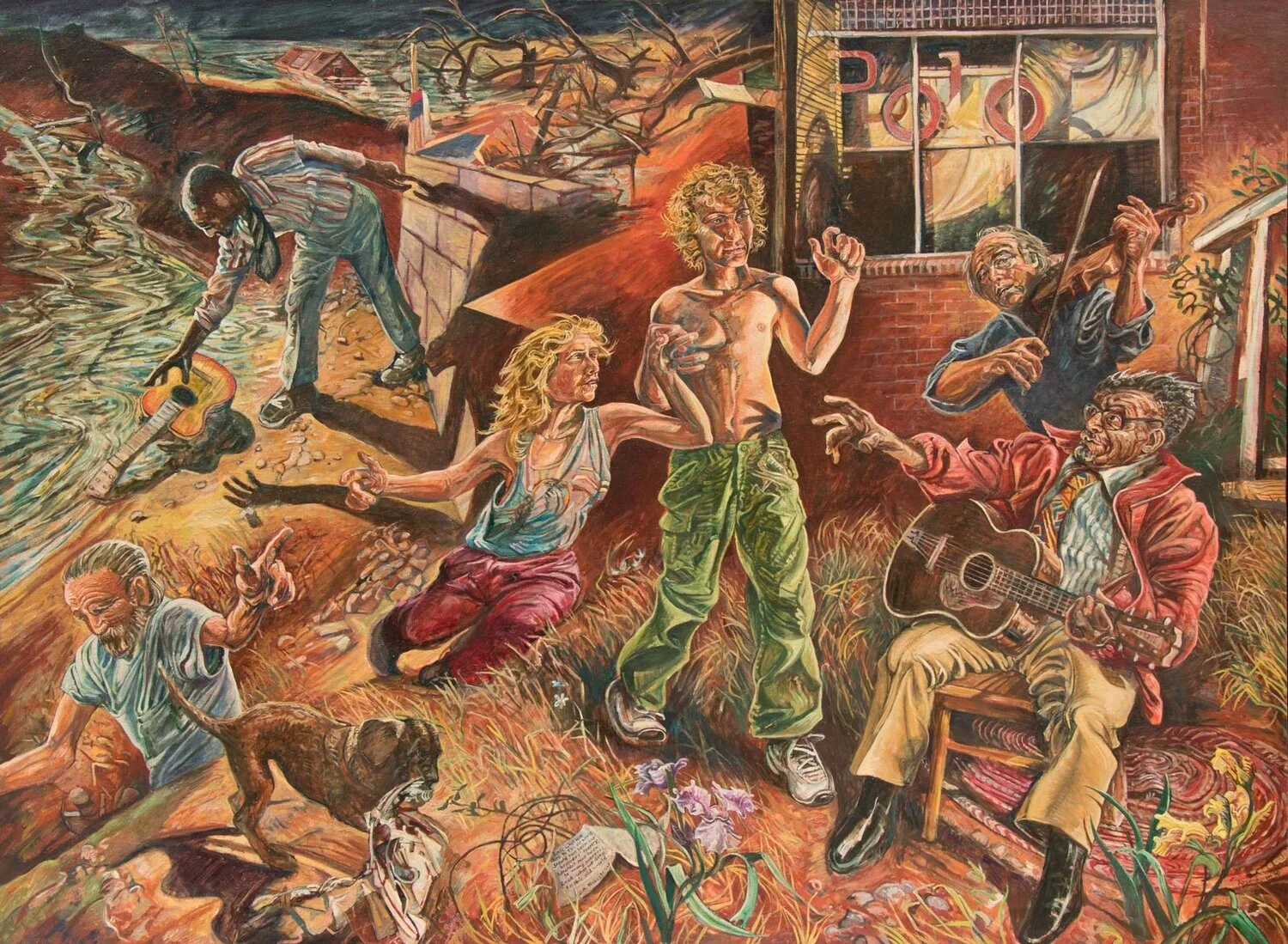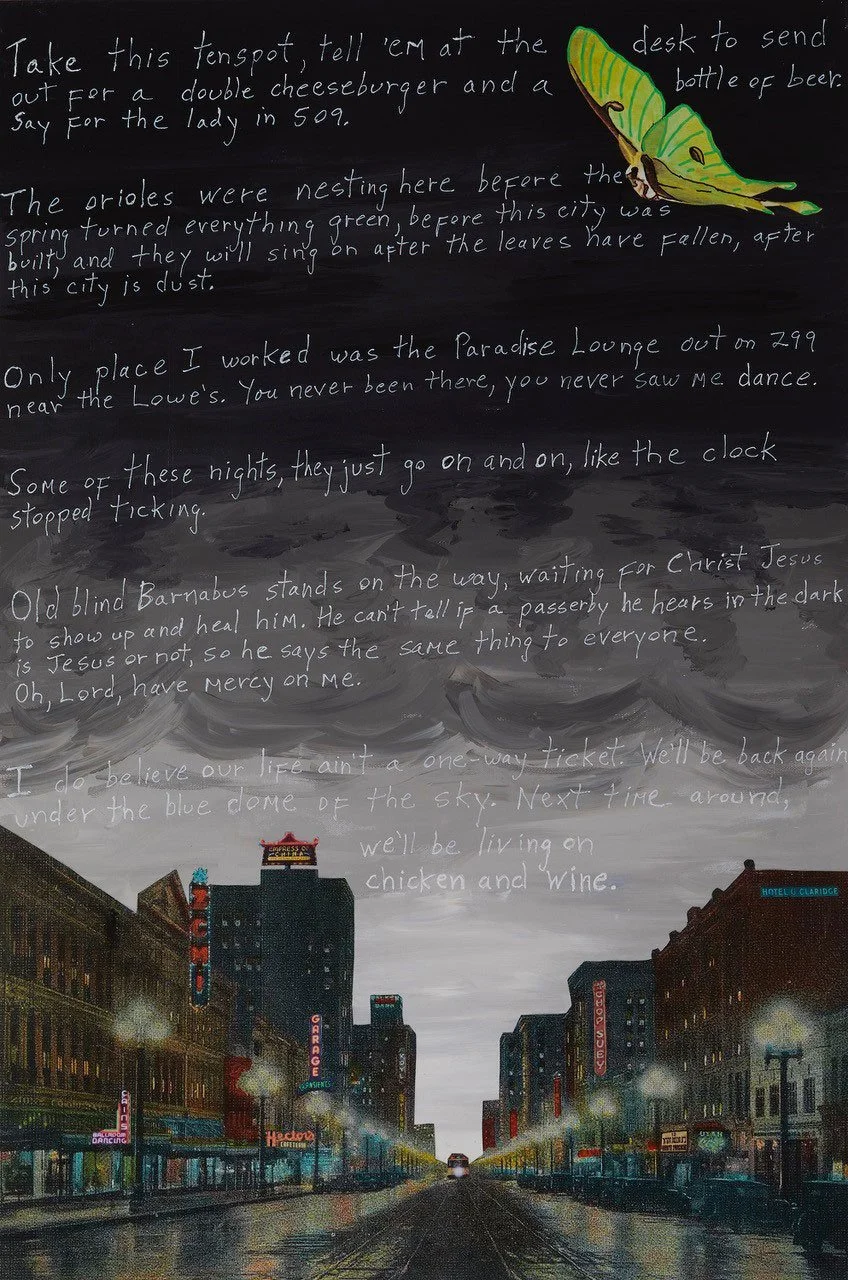Detail of Coming in on a Wing and a Prayer. VIEW ON ARTSY
INTERVIEW WITH LEN JENKIN
Len has called his paintings “narratives, stories hidden and obvious at once.” They often include language as well as images. He calls himself “a painter of the imagination and the American scene.”
He is also a playwright, screenwriter, and novelist, and his visual art is influenced by a life in storytelling, stage design, and directing.
Four of his paintings were recently in the year-long exhibit, The GreatMystery Show, at the American Museum of Visionary Art in Baltimore, Md.
Two of them are now in that museum’s permanent collection.
Recent solo shows were at Wild Project Gallery in NYC; Chocolate Factory in Long Island City; Coney Island USA Annex for the Arts: Yalo Gallery in Water Valley, Mississippi; Undermain Theater Gallery in Dallas, Texas.
Lee: Comment on your American Scene paintings vs your imaginative works
Len: Well, I think a lot of the landscapes in my painting and a lot of the backgrounds and some of the figures are out of my experiences in the American Southwest, and they're very spare in that way. I use Turner's yellow, a lot of Prussian blue, a lot of colors, I connect with that landscape. The ones in the current exhibit are more imaginative painting
Lee: Are we going to get to some of the paintings in bit, you're also a playwright, a screenwriter, and a novelist?
Len: I'm ashamed to say I've done all these things. Yes.
Lee: Can you tell me about your background and how you started and all these different endeavors?
Len: I was always a writer and in my twenties, I was a poet and a novelist and I don't think I was very good at that. But in any case, I started to write plays and I started to write plays without knowing very much about it at all. And the very first play I wrote was a play called Kitty Hawk and it was about the Wright brothers, or actually, it was about two people who were confined in asylums, who thought they were the Wright brothers and they meet together on a beach and build an airplane. The first play I ever wrote. And unlike a lot of my prior work in poetry or novels, the first place I ever sent this play, they immediately called up and said, we'd like to produce this. So I said to myself, Hey, this is something, you know, I wrote a lot of plays after that. Most of my writing has been for the theater and like a lot of people who write for the theater, I've also done some work for television and for film over the years.
Lee: Can you elaborate on some of what you've done with TV and film ?
Len: Yeah, way back I did. I spent some time in Los Angeles and I did some episodes of classic television shows. I did. If people watching this, remember them, I did Fantasy Island. I did the incredible Hulk. I did Quincy MD. I did a show called Family. A lot of these television shows have long disappeared forever. I did a very nice television show called The Days and Nights of Molly Dodd. It was a better piece of television. I did some screenwriting and I'm currently involved in a project for television which I can't talk too much about, but it's waiting to get rolling. There's a big sort of historical epic. So I'm still working in TV and I'm still working in the theater a bit. But I think over the last 10 years, I'd say the main thing I've been interested in is painting. I think a lot of, a lot of my feeling about paintings comes from set design and from lighting, from costume and from all that, which I did for many years when I wasn't painting, I did all that kind of work. So in a way it's, it's all the same to me. It's all storytelling in a way. And the paintings are l like snapshots.
Lee: Was it something you started all of a sudden it was kind of or did you kind of gradually, Did you do storyboards for theatrical projects?
Len: No, I never did storyboards I looked at a lot of people's storyboards and I looked at a lot of costume design and I looked at a lot of light plots, but I, you know, I was always a visual artist as well when I was young, even when I was in college a long time ago, I made big sculptures constructions and a lot of mirror and plexiglass and electrics. And these are very large. I gave them all away. One went on tour with Guggenheim museum, which is great.
Lee: Do you have any examples of that? I'd love to see examples of that?
Len: I have none of those, the one that went on tour with Guggenheim was called all-day Sucker and it was just a gigantic, like 10 foot tall lollipop covered with rhinestones. It was this kind of work. I did a sun machine, which was a big construction of a mirror and orange plastic that was backlit and had a dimmer in the center of it that people in the audience could turn up, like turning up the glow of the sun. The biggest piece I ever did was a kind of carnival, which I think had about 20 linked silver cages that went all around the room. Each cage was not so large. And there were various strange objects and things in the cages. So I make big sculptures like this, and I don't think any of them exists anymore. Like, as I said, I gave them away.
Lee: So did so you were friends with art Rosenbaum back then? Did you collaborate with him?
Len: Well, at that time, when I was, was friends with him, I wasn't making artwork. I was a writer and I knew art mainly as a musician at the beginning because he had great music parties at his house and all kinds of fiddlers and banjo players and country musicians would show up somehow in New York at Arts Place and they would play great music till all hours. And I was there all the time and I knew he was a painter and I saw his paintings even then, but I first knew him as this amazing musician and who throw all these music parties. And and then I began much later to know him as an artist and painter
Lee: So you play music yourself?
Len: No, I don't. I play guitar very badly.
Lee: Did these music parties intersected with the theater crowd as well?
Len: No, no, it didn't. Cause I wasn't yet doing that. Okay. I was writing, I was writing poems and novels and I wasn't yet working in the theater at that time
Lee: Did you recite your poems at (Art’s events)?
Len: That was unlikely to happen. I did read a lot of poetry, but not in that setting. I was one of the youngest people around when people like Alan Ginsberg and Gregory Corso were reading poems but I did a bit of that and I used to go to the village
Lee: Comment on the development of your painting practice
Len: For a long time, I didn't do visual art until my wife and I went to Wisconsin. I got a job teaching there in the winter and we hated it and it was cold and the house was small. And you know, if I told you this story, I'll tell, I'll tell people I hadn't done visual art for a long time.And I was very much at ease and at loose ends out there. And I went to a laundromat which had a bulletin board. And on the bulletin board, there was a little card that said $50 a month, rent studio, space art in a shared artists studio. And did I say, just say $50 a month? Yeah, that's what it was. And I said I'm going to do this. And I signed up at this little place, which is a loft in Madison, Wisconsin, and various people used it to make paintings. And I rarely saw anybody but myself there. I saw other people's work sitting around, but I was usually there by myself and I started to paint pictures again, I didn't have an easel. I painted flat or propped up and I started to go there every day and I began to make visual art again,. It's probably the late eighties. And I've been making visual art ever since. it got me back into it sort of magically.
Lee: And so when did you have your first exhibit? Comment on your early sales.
Len: The thing that really encouraged me was the first time I would sell paintings it was to friends of mine, I had a number of friends who were very supportive about my work right off the bat. And that was really great and very encouraging At the first show I had, I'm trying to remember where it was. I think it was at a storefront. There's an organization in New York city called Chashama that hosts all kinds of galleries. And they had a storefront on 37th street that they let me exhibit work in and that was it. And people couldn't go in, they could just walk by on the street. And that was the first place. The first really big show I had was at a place called Coney island USA out in Brooklyn. And it was such a big space that I was able to show almost everything I'd painted up to that time. And it was a crazy crowd that came there, especially on summer weekends. So that show was great. And early on, I did a number of shows in the lobbies that are exhibition spaces of theaters because I knew people there. And so I showed work in Dallas. I should work in New York City in that way. And very often used wonderful exhibition spaces. And it's great to show work in the theater lobby because every night, like 300 people come through. We will travel to spaces. I had a show that was important to me. It was a gallery in a small town in Mississippi called Water Valley near Oxford. And that was the first time I sold everything in a show. And the reason why, because there was a flood, Everything was destroyed and she had a wonderful insurance policy.
Lee: Why were you in Mississippi? Was it, did you travel there for, because of theater?
Len: Actually, I was there just to see this gallery and I was there because art Rosenbaum had shown there and he had recommended me to the gallery. The gallery is in a wonderful town a little north of Oxford. So that's it, that's some things abou,t shows I've done
Lee: Well. That's great. You traveled and found these different galleries to show the work. And it was unusual spaces, but it's very interesting to me. So so you had a show at the American Museum of Visionary art recently?
Len: Yeah. That was a group. That's a group show. There was a show that was up there for about a year called The Great Mystery Show and I had four pieces in that and two are now in their permanent collection.
Lee: Let’s look at some recent pieces and works in the current show
Len: This sold very quickly. This was only in my house we two days after I finished it. This is called the border of perception and belief. My daughter is a philosophy professor and she gave me that title and I was talking with her and she just said that, that there's such a thing that she thinks about in the work she does, which is the border between perception and belief. And that idea really struck me. And I took the idea very literally in his painting. There's a a barrier which is black and white, like a railroad crossing barrier
In the center of this picture. And on one side, as I'm looking at it's on the left are the forces of perception. And there, those forces involve a hall of mirrors with people whose heads seem to be gian eyeballs a man wearing x-ray specs, a woman wearing a reality goggles that hall of mirrors, the forces of sort of a blunt cartoony version of the forces of perception. And another side, there's an image of belief. There's a sort of figure of wisdom of the strange hat as a man holding a the Hebrew symbol of the sefirot. There's a couple of Tibetan priests with gigantic horns. It's a hall of prayer. And so it's kind of a blunt cartoony vision of the of the philosophical idea of that border. If I described this painting, it also seems to me to be a lot of fun as I'm looking at it now
Lee: Did you make drawings and studies prior to making this painting? Comment a bit more on the composition
Len: I make a lot of drawings and for this one, I did make very many drawings beforehand. So but the core idea, as I said, came from the phrase of my daughters. And when I thought of this sort of railroad crossing barrier as a line between these things and, you know, the background, it's all sky it's sky and sky stars, Starfield, and you know, so in a way it's all floating and, and there's these flames above and below, you know, it's when you asked me to read out a picture like this, I can do it to a degree, but there's a portion of it that's a mystery to me as well
Lee: Comment on Awake oh Sleepers
Len Jenkin, Awake O Sleepers, 2009, Oil on canvas, 30 × 40 in, 76.2 × 101.6 cm. VIEW ON ARTSY
Len: This is much earlier. This is one of the few oil paintings I've done. I haven't done that many, but this is oils. And you know, it began in pencil or part of it were pencil. And then as I worked on it, it seemed to me interesting and strong to leave some of the pencil and some of the scratches. And so there are these two sleeping figures and a sort of demonic figure. Who's about to go behind that billboard of the heavens. who is stealing their shoes. I don't know if that's so clear and there are these wolves. And that again, to me is a very Southwestern landscape. And the whole thing also has a sense of a swirling sort of the rhythm of it is circular of the whole painting. And I've always loved billboards and the lattice work below them. So there's some of that.
Lee; I just, I just love the vibe. I don't know why it brings to mind, it reminded me of Wise Blood, You know what I'm saying, John Houston, it reminds me of kind of this kind of chaotic half-asleep sort of town
Len Jenkin, Bacchanal, 2018, Acrylic on canvas, 24 × 36 in, 61 × 91.4 cm, VIEW ON ARTSY
Lee: Comment on Bacchanal
Len: This is a much more recent piece and that lettering “Dancing Tonight” is taken off an old neon sign for a dance hall somewhere in New York in the forties. And then there's that powerful tree. And again, there's a star stream, a darker and different kind of star stream, but again, it's a sort of version of the Milky Way, and below are these figures. And two of them look out at the audience, make direct contact,, he one with the bull mask and the other wearing the little dunce cap on the opposite side and the rest are not, they're preoccupied with themselves. And it's, it's deep in the darkness. And with these figures, a lot of them are wearing those strange little dunce caps, some are not. And I don't, I don't know whether they're those figures are, are sort of demonic or just people. But I do know why I put the skull in the center. That's a very Renaissance image and it's a reminder of death in the midst of life. And that was also the standard Latin phrase for it. I'm going to try to remember, which is I can't repeat the Latin, but the Latin says, even in Arcadia, even in paradise, I am here and that's death speaking, and there's a bunch of Renaissance paintings, which is usually like peasants chasing peasant girls and partying around the haystacks. And then there'll be the skull as a reminder even in the midst of life. So, so I liked that motif and I guess this is my version of it.
Len Jenkin, Coming In On a Wing and a Prayer, 2011, Oil on canvas, 48 × 48 in, 121.9 × 121.9 cm. VIEW ON ARTSY
Lee: Comment on Coming in on a Wing and a Prayer. This is the only piece in the exhibit that is painting and collage
Len: A fair amount of this piece is collage toward the bottom. It's from a blowup of the postcard from the turn of the century of a ride in Coney island called the Dragon's Gorge. And there's a lot of painting on the collage. So it's hard to distinguish., it's a vision of an evangelist, a guitar-playing evangelist wearing Angel's wings, arriving on a comet. And he's arriving as a sort of savior or a sort of vision of salvation for the dark world below and in the world below are two corpses. Other people watching it and the man of the chair is dead. There's a dead woman. And it's a dark world with flames within that sort of collage and those demonic figures and the evangelist arrives into this dark world for better or worse. I think that figure of the evangelist is based on a real person. He was an African-American preacher who would wear big Angel's wings when he preached, and he also played the guitar. I forget his name and where he was active. He wasn't much of a musician, but he was a very good showmana nd a serious preacher. I saw a photograph of him, I think, wearing these angels wigs, which he made for himself.
Lee: So I wanted to ask you again about Art Rosenbuam. Do you feel there is a philosophical intersection between your practices?
Len: I don't know if there's a connection between philosophy. I think Art is a great, great American painter and I think he's the best we've got. I think he's extraordinary in the seriousness of the work, the vigor of his painting. It's often mysterious, often very heartfelt, its connection with music. I'm a great admirer of his and what he does. I learned from looking at his work, but I'm not nearly the painter he is. And I think I have a different kind of sensibility in a way.
Wing and a Prayer reminds me of a bit of Art’s work at the recent show Dodd galleries because of the multiple figures but I agree your practices are very different Tell me more about pieces by Art Rosenbalm you really resonated with?
There's a great painting called Rakestraw’s Dream, which I think, you know, which I'm a great admirer of there's a wonderful painting, which I think is called a Man Has Been Here a Long, Long time. And it's a painting of the African-American sculptor, Dilmus Hall, who Art knew. And I liked that picture very, very much. A whole lot of the work. I like a lot. Oh, there's a painting I love Outside Carnesville . There's a terrific painting. that hangs in my living room that I like a lot. It's called Old Cornelia Highway
Len Jenkin, The Four Horsemen of the Apocalypse, 2021 ,acrylic on canvas, highway reflectors, 60 x 60 in
Yes. This is a plague painting. Those are plagued doctors. This is a COVID painting. Those large figures at the bottom are plagued doctors. And if people listening to this and don't know what they are plagued doctors in the black plague in, in England, where physicians who've walked through the streets, wearing these very strange outfits, and they mask looked like the heads of birds. There are drawings of these, and those masks would be stuffed with aromatics to protect them from the miasma, from the plane. Their hats did not have their hats to not have those little carts in them that say that's from the mad Hatter's hat in Alice, in Wonderland. It gives the price of their hats, their eyes, a highway reflectors, those two figures. And this is called the four horsemen of the apocalypse.
It's, it's very again, it feels to me a little medieval or a little, you know, our world is very small, that little landscape in black, right above the green at the very bottom where the human beings, there's a giant figures that loom that world in a huge way. And there are the plague doctors, and there's the four horsemen of the apocalypse. And then there's one sort of serene figure sort of DVD riding above. And that's not, you know, I wish I had a better photograph of that. The painting is five by five and was taken with my cell phone and I wish it was better and bigger, but it's a painting of like a lot.
Lee: Oh, kind of reminds me of this: The world is so small, I guess this is ordinary people in that world, but you think of the media, you think of certain aspects of, you know, entertainment, the entertainment business, it's kind of a kind of looms, very large compared to ordinary people.
Len: I wanted that feeling of it too. So, so, yeah. And there's also this, there's a couple of sort of skeletal windmills in that picture as well.
Lee: Tell me more about those windmills.
Len: I don't know any more about them. They're sort of on shelves of rock that are coming up from the sides of the painting. I don't really know, you know, I can't sort of read them out in the same way that I can talk about the rest other figures themselves. But again, it's, it's a painting for the plague. I mean, it's, these are hard times, and those speakers there are colorful and fierce and in motion, but they're kind of demonic to me.
Lee:They're powerful.
It reminds me of these reoccurring nightmares and dreams. I would have a dream where I'd be walking in this strange world and it keeps on reoccurring
Len Jenkin, Down Down Down, acrylic on canvas, 30"x 48". INQUIRE
I'm currently doing a parallel picture to this of a woman falling she's falling into the ocean. This is off of something that I wrote. I wrote it. You just mentioned dreams. I wrote a dream about a falling man. He began falling faster and faster and shouted some things out as he fell. And it wasn't a dream I had, I just sort of had written this. And then again, there's that curtain of stars that I like. And one of the lines I'd written was falling down along the curtain of stars. And that's what inspired that figure in that. The strangest part of this to me is not even the man falling, it's that little world below and that strange building and those odd little lights. I don't know where he's falling to, but it's just down, down, down which is out of Alice in Wonderland. She saysshe goes down the rabbit hole and she starts to fall. And Lewis Carroll at one point says down, down, down, will this fall now?
Lee: Well, it's strange. You have this little bird on the side and that's, that's different, you know,, it's something about it. I didn't know, but it's, I know this reminds me of memory sitting outside at a rather deserted bar in a certain area of Athens, Georgia late at night, and it's kind of like your falling or looking at yourself from above sort of thing, but it could be anywhere.
So I picked this one from your website :
Len Jenkin, Vox Humana/Storm, acrylic, collage on canvas, 24 x 36 in
I know exactly what this is. This is pieces of language floating up out of a city scene. This is one of two parallel paintings. And my idea was the scene at the bottom is collage. And it's the kind of collage I like. That trolley coming at you is not actually there. I put it in and a lot of the neon signs I put in, so the collage has been messed with, but it's basically extended to the bottom there
Lee: I just love the way it connects to the language
Len: The language is just various phrases floating up out of people in these buildings. So it's just stuff out of people's mouths.
Lee. So this could be any time. So these people could be speaking at any time in history?
Len: It's not in my mind, it's not one voice. The things are separated. It's a bunch of different voices.
Lee: So, so it could be kind of the beyond time.?
Len: It could very well be beyond time. It's just all kinds of people. And it could be different times, the person who is saying, take this 10, spot him at the desk. It's not the same person saying some of these nights. I mean, it's various voices and there's a parallel piece, which is basically the same cityscape with other voices in it.
Lee; So you have a gray sky and this one is quite interesting.
Len: The parallel one has a very intense red Twilight sky. Its called Vox Humana/Twilight
Lee: I have these unusual nightmares or dreams that come in. I think some of that reminds me of your work. These very strange dreams with very strange characters
How does this new work differ from your early, late eighties work?
Len: Much bigger, much bigger.
I think the thing for me to talk about is what I'm doing right now in my studio. I did for the first time a painting with just language. I mean many people have done this. Many artists had done this, but I was a writer for many years and I never did it. I've included language in a lot of paintings, but this thing is just language. It's just pink on black. it's just a story on the canvas . I think I'm going to do more of these. I like it. I like the way it looks. It's very simple. And it's interesting to me. So it's something I'm exploring.
Lee: Comment on your life during the pandemic
Len: Well, I'm, I'm not in a city the way you are. I live out in the country in the woods. So I see people when I go to town or go to the supermarket.I don't know a lot of people who've actually gotten COVID. I know friends of mine got the shots early and, but it's still, it's still very present., I think this is true everywhere. It's gotten very confusing about mask-wearing because everywhere I go, half the people are wearing masks and half a not, and it's a whole blurry thing
Lee: So when people were thinking that the COVID was over with, and then they stopped wearing the mask cause they were vaccinated.
Len: And supposedly now it's back and people need boosters. But, but I mean, because we live so quietly back here and I'm not in the streets of the city I feel pretty much the same. I mean, it affects me and I think about it and we don't go to restaurants very much and, and so on. And I haven't been to the city for a long time. I may start to go back there again.
Lee: So that's the thing with me, I'm in a situation where I am going to be moving I’m just maybe putting it on hold. I was in a downtown area today. It was desolate The coffee shop had closed permanently. It is an area that's usually vibrant but just didn't feel the same at all.
Len: Well, it's all much quieter everywhere. Right.

